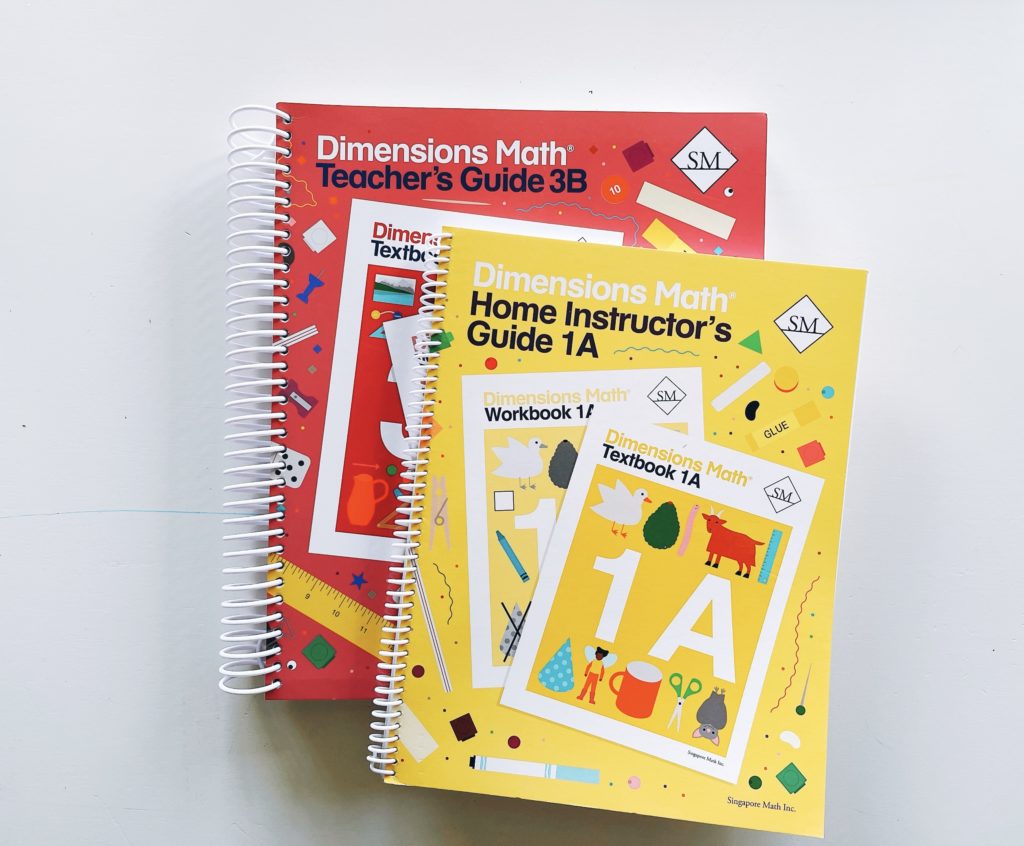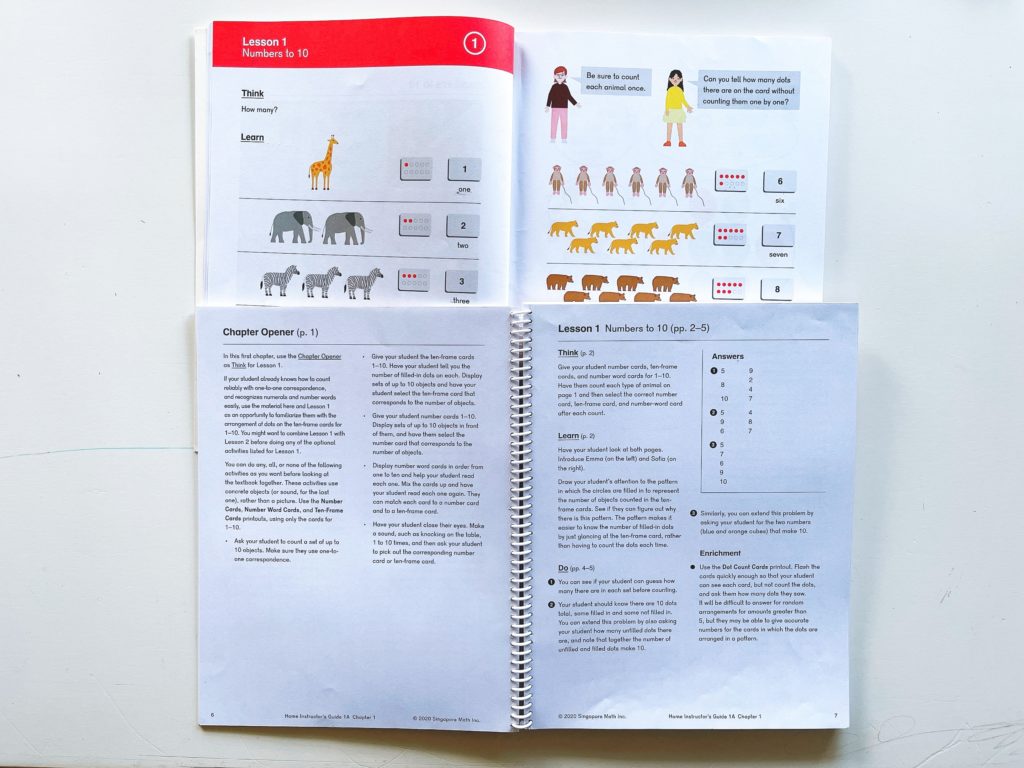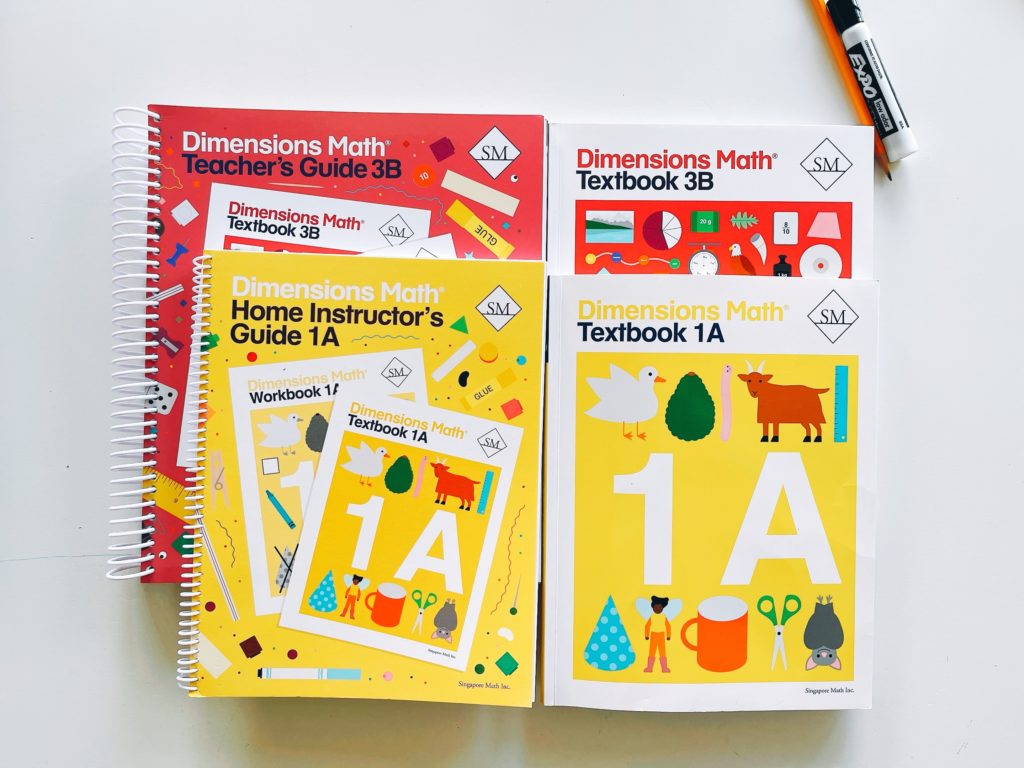We can pick the best curricula, but the key to successful learning is teaching and implementation.
Who will benefit from this post
While I’ve given several examples for Level K, this post is applicable and beneficial to
- The parent teaching Dimensions using Singapore Math
- The parent starting Singapore Math at Pre-K or K level
- The parent teaching any level of Dimensions Singapore Math
- For anyone interested in Singapore Math and its teaching methods
You can also check out my post on “The Brilliance of Singapore Math” and read my thoughts on why it is a robust curriculum. You can also check out their website for samples from books and placement tests if you ever choose to buy them. Read on for the five ways to maximize the effectiveness of implementing this program.
the five tips
1. Get the Teacher’s Manual

You might wonder whether you need the Teacher’s Manual or Home Instructor’s Manual. Singapore Math recently developed the Home Instructors Manual explicitly for the homeschooler. On the other hand, the teacher’s manual offers lots of great activities to teach in group settings; in other words, it is developed for a school setting. You can use either one but USE IT, including the Kinder Level. You might wonder how hard math can be for a kindergartner? I’m here to tell you there is great value in buying the guides. The guide gives you ways to introduce certain concepts to your kids, and how you teach does matter. Your kid is developing their number sense and learning how to manipulate numbers differently. While math may come easy to some kids, others need explicit guidance to build those skills. Remember that math is not just about adding and subtracting numbers. It is the ability to analyze, observe, explore, manipulate, and execute.
2. Do the Think Activity

Do not skip the Think activity in the Textbook. These exercises are brilliant as there is so much analysis involved. They can discover patterns, analyze what the picture is telling them; they can add, subtract, multiply, and divide without writing out an expression; they can manipulate numbers mentally, tell stories, and can solve simple problems.
Here are some tips for doing this activity with them.
✅ You might be tempted to point out your observation. Hold on to it until your kid has time to explore and is out of ideas.
✅ Your kid may point out patterns and observations not listed in the guide. Allow them to explore beyond the obvious and commend their findings.
✅ Ask questions if your kid is stuck, but do not provide the answer until they have tried.
3. Pay Attention to the Build Up
Singapore Math is a mastery-based program which means that each level will master the concept once and then move on. What is learned at one level is then brought back to the next level with a build-up.
A. Addition and Subtraction build-up
For instance, there is a build-up to teaching addition and subtraction in the early levels.
- From Pre-K Level, Singapore Math introduces bringing two groups together to make a ‘whole’ group.
- At the K level, they teach your child to tell number stories.
- The number stories are then plugged into NUMBER BONDS. For those new to Singapore Math, pay attention; number bonds are a critical tool that your child will use as the difficulty level increases. It is a representation of a whole-part model.
- NEXT UP -writing a number sentence. For this they need to know all of the above.
- your child should be able to recognize the number story (3 blue triangles and two black circles make five shapes)
- convert it into a statement (3 and 2 make 5)
- replace the keyword ‘AND’ with ‘PLUS’ and ‘MAKE’ with ‘EQUALS.’
- plug it into a number bond model
B. Word Problem Build-Up
Another build-up I have seen is word problems. In Level K, your child learns number bonds; this builds up with each level. When you get to level 2, you will use it to solve word problems and visually build models with it. In level 3, these become mental exercises as you solve complex word problems. This is a form of scaffolding instructions with each level in incremental steps in order to assist your child in the process of mastery.
4. Use your own strategies as you see fit.
Remember that a curriculum offers a guide and gives you tools to teach. Use it as a guide. If you find a better way to teach, go for it. When I was introducing the + and – symbol, I wanted to make sure my 4.5 year old could write a complete operational sentence, so I did the following with him before using the workbook.
- We built out each problem with counters (you can use any manipulative you have as long as you can make two groups).
- I then had him write out the number sentence on a whiteboard. He would convert his counter-image to a concrete equation.
- I then had him go back to the textbook and workbook to complete the exercises.
5. Take a Break
Have you hit a wall? If you and your child are frustrated and cannot get past a lesson – TAKE A BREAK. Take a few days off from that lesson.
It’s ok to pause and come back to a new lesson if your child is not getting it right away. They are not going to forget what they have learned. I was trying to teach the concept of 4 equations from one story, but my 4.5-year-old did not get it and was starting to feel frustrated.
One morning, I woke up with an idea. I almost think I had a dream about it. I took a bunch of toys and had my kid tell me four stories using them.
For example:
👉 Four square Magna Tiles were playing with three triangle Magna Tiles, and that made seven friends all together.
👉 5 red cars met two yellow cars, and they all parked in the seven spot garage.
Sometimes, we need to find a different way to teach a lesson, and taking a break from it will help us start over with a fresh mind.
Conclusion
Another piece of advice I will give you is to outsource learning. If math is challenging for you to teach, ask for help, see if dad will teach it after work, outsource it, find a tutor, or sign up for the video lessons from Singapore Math. Yes, they do offer those.
Feel free to ask me questions. If you found this helpful, like, comment, and share it with those who might find it beneficial.



